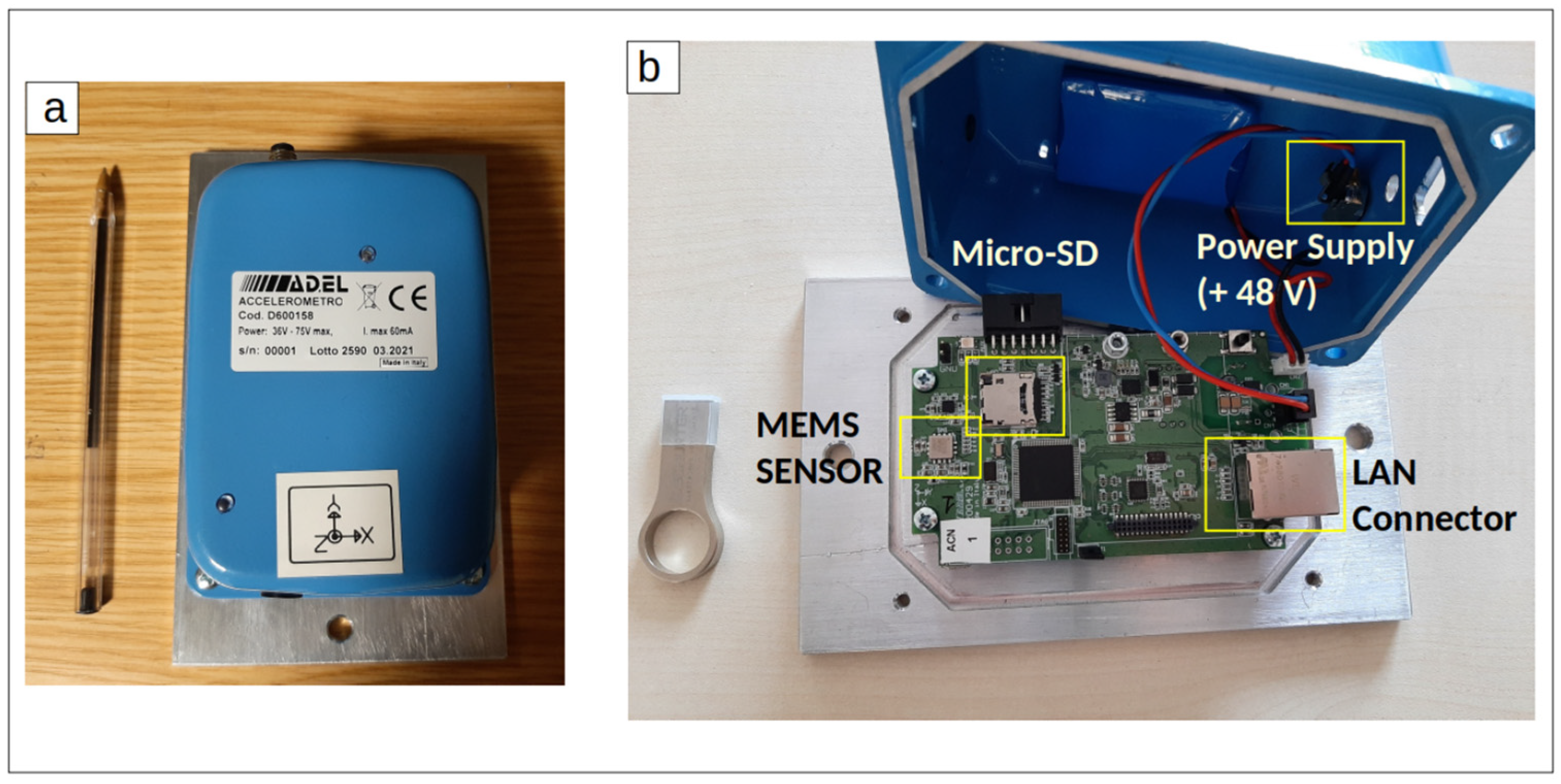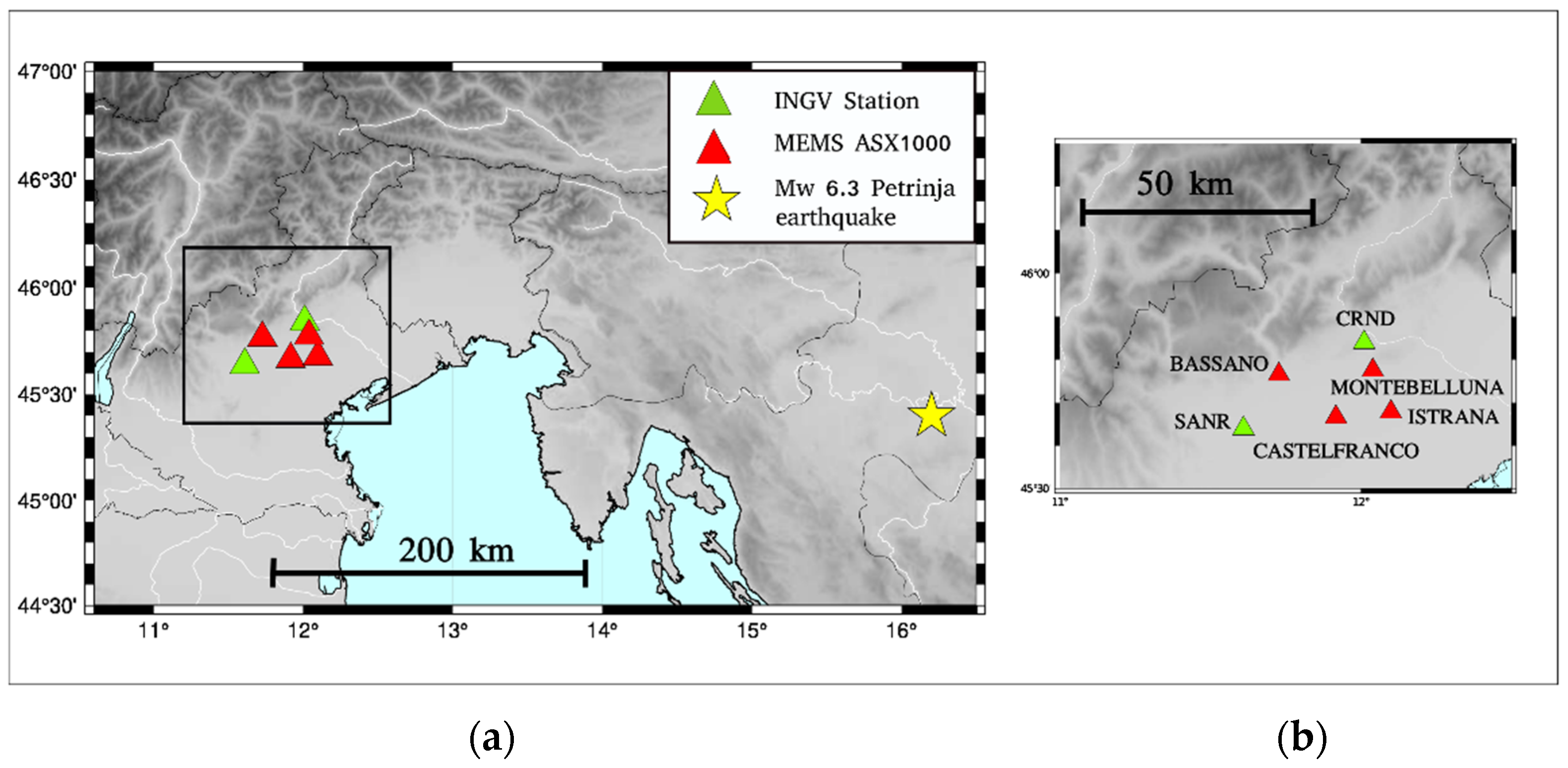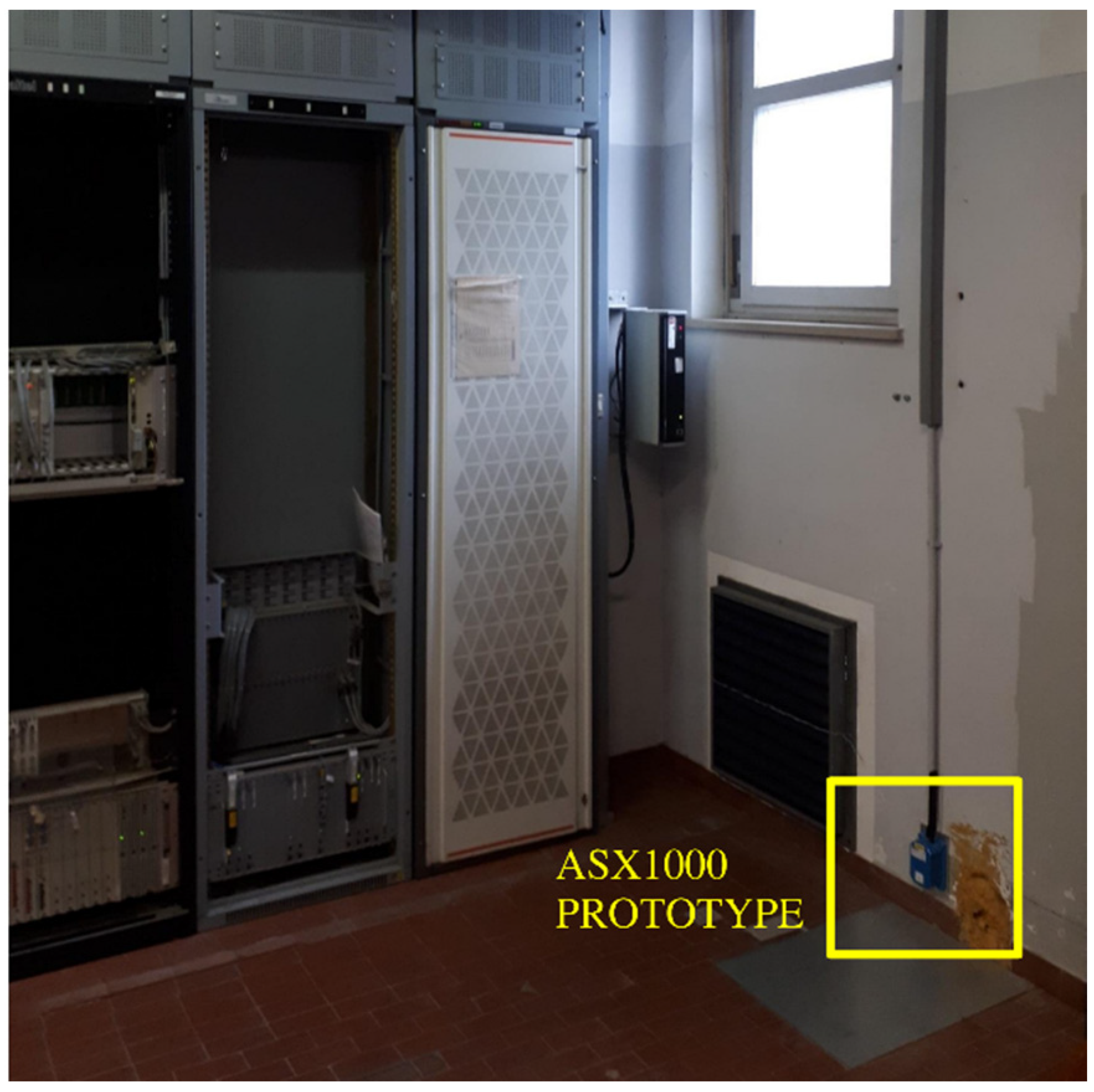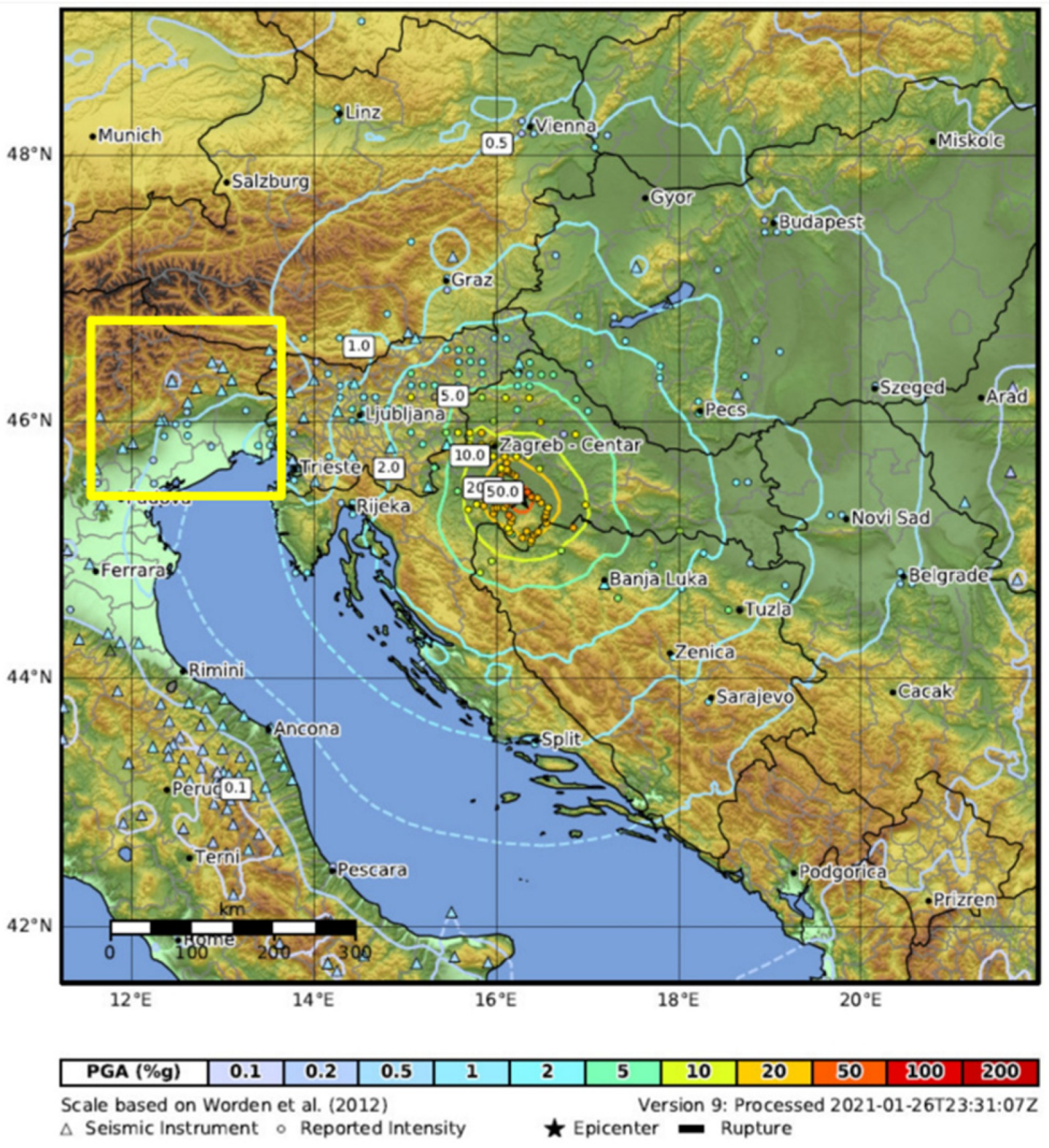Characterization of Distant and Moderate Earthquakes with Inexpensive MEMS Sensors: Application to the Mw 6.3, 29th December 2020, Petrinja Event
Abstract
:1. Introduction
2. Methods
3. Results
4. Discussion
Author Contributions
Funding
Institutional Review Board Statement
Informed Consent Statement
Data Availability Statement
Acknowledgments
Conflicts of Interest
References
- Ansal, A.; Tönük, G.; Kurtulucs, A. Microzonation for Urban Planning. In Earthquakes and Tsunamis; Springer: Dordrecht, The Netherlands, 2009; pp. 133–152. [Google Scholar]
- D’Alessandro, A.; Scudero, S.; Vitale, G. A Review of the Capacitive MEMS for Seismology. Sensors 2019, 19, 3093. [Google Scholar] [CrossRef] [PubMed] [Green Version]
- D’Alessandro, A.; D’Anna, G. Suitability of Low-Cost Three-Axis MEMS Accelerometers in Strong-Motion Seismology: Tests on the LIS331DLH (iPhone) Accelerometer. Bull. Seism. Soc. Am. 2013, 103, 2906–2913. [Google Scholar] [CrossRef]
- Shearer, P.M. Introduction to Seismology; Cambridge University Press: Cambridge, UK, 2019. [Google Scholar]
- Wald, D.; Lin, K.-W.; Porter, K.; Turner, L. ShakeCast: Automating and Improving the Use of ShakeMap for Post-Earthquake Decision-Making and Response. Earthq. Spectra 2008, 24, 533–553. [Google Scholar] [CrossRef]
- Evans, J.R.; Allen, R.; Chung, A.I.; Cochran, E.; Guy, R.; Hellweg, M.; Lawrence, J.F. Performance of Several Low-Cost Accelerometers. Seism. Res. Lett. 2014, 85, 147–158. [Google Scholar] [CrossRef]
- Homeijer, B.; Lazaroff, D.; Milligan, D.; Alley, R.; Wu, J.; Szepesi, M.; Bicknell, B.; Zhang, Z.; Walmsley, R.G.; Hartwell, P.G. Hewlett Packard’s Seismic Grade MEMS Accelerometer. In Proceedings of the 2011 IEEE 24th International Conference on Micro Electro Mechanical Systems, Cancun, Mexico, 23–27 January 2011; pp. 585–588. [Google Scholar]
- Shaeffer, D.K. MEMS inertial sensors: A tutorial overview. IEEE Commun. Mag. 2013, 51, 100–109. [Google Scholar] [CrossRef]
- Scudero, S.; D’Alessandro, A.; Greco, L.; Vitale, G. MEMS Technology in Seismology: A Short Review. In Proceedings of the 2018 IEEE International Conference on Environmental Engineering (EE), Milan, Italy, 12–14 March 2018. [Google Scholar]
- Crone, W.C.; Sharpe, W.N. A Brief Introduction to Mems and Nems. In Springer Handbook of Experimental Solid Mechanics; Springer: New York, NY, USA, 2008; pp. 203–228. [Google Scholar]
- Shi, G.; Chan, C.S.; Li, W.J.; Leung, K.-S.; Zou, Y.; Jin, Y. Mobile Human Airbag System for Fall Protection Using MEMS Sensors and Embedded SVM Classifier. IEEE Sensors J. 2009, 9, 495–503. [Google Scholar] [CrossRef]
- Boaga, J.; Casarin, F.; De Marchi, G.; Valluzzi, M.R.; Cassiani, G. 2016 Central Italy Earthquakes Recorded by Low-Cost MEMS-Distributed Arrays. Seism. Res. Lett. 2019, 90, 672–682. [Google Scholar] [CrossRef]
- Lawrence, J.F.; Cochran, E.S.; Chung, A.; Kaiser, A.; Christensen, C.M.; Allen, R.; Baker, J.; Fry, B.; Heaton, T.; Kilb, D.; et al. Rapid Earthquake Characterization Using MEMS Accelerometers and Volunteer Hosts Following the M 7.2 Darfield, New Zealand, Earthquake. Bull. Seism. Soc. Am. 2014, 104, 184–192. [Google Scholar] [CrossRef] [Green Version]
- Liu, C.; Lin, C.-H.; Chung, T.-K.; Chang, K.-S.; Liu, Y.-S.; Chou, B.C.; Tsai, R.C.-F.; Shen, N.Y.; Chen, B.S.; Cheng, E.C.; et al. MEMS Technology Development and Manufacturing in a CMOS Foundry. In Proceedings of the 2011 16th International Solid-State Sensors, Actuators and Microsystems Conference, Beijing, China, 5–9 June 2011; pp. 807–810. [Google Scholar]
- Kong, Q.; Allen, R.M.; Schreier, L.; Kwon, Y.-W. MyShake: A smartphone seismic network for earthquake early warning and beyond. Sci. Adv. 2016, 2, e1501055. [Google Scholar] [CrossRef] [PubMed] [Green Version]
- Nof, R.N.; Chung, A.I.; Rademacher, H.; Dengler, L.; Allen, R.M. MEMS Accelerometer Mini-Array (MAMA): A Low-Cost Implementation for Earthquake Early Warning Enhancement. Earthq. Spectra 2019, 35, 21–38. [Google Scholar] [CrossRef]
- Cochran, E.; Lawrence, J.F.; Christensen, C.; Jakka, R.S. The Quake-Catcher Network: Citizen Science Expanding Seismic Horizons. Seism. Res. Lett. 2009, 80, 26–30. [Google Scholar] [CrossRef]
- Cascone, V.; Boaga, J.; Cassiani, G. Small Local Earthquake Detection Using Low-Cost MEMS Accelerometers: Examples in Northern and Central Italy. Seism. Rec. 2021, 1, 20–26. [Google Scholar] [CrossRef]
- Chiaraluce, L.; Di Stefano, R.; Tinti, E.; Scognamiglio, L.; Michele, M.; Casarotti, E.; Cattaneo, M.; De Gori, P.; Chiarabba, C.; Monachesi, G.; et al. The 2016 Central Italy Seismic Sequence: A First Look at the Mainshocks, Aftershocks, and Source Models. Seismol. Res. Lett. 2017, 88, 757–771. [Google Scholar] [CrossRef]
- Galadini, F.; Poli, M.E.; Zanferrari, A. Seismogenic sources potentially responsible for earthquakes with M ≥ 6 in the eastern Southern Alps (Thiene-Udine sector, NE Italy). Geophys. J. Int. 2005, 161, 739–762. [Google Scholar] [CrossRef] [Green Version]
- Anselmi, M.; Govoni, A.; De Gori, P.; Chiarabba, C. Seismicity and velocity structures along the south-Alpine thrust front of the Venetian Alps (NE-Italy). Tectonophysics 2011, 513, 37–48. [Google Scholar] [CrossRef]
- The Math Works, Inc. MATLAB, Version 2020a; Computer Software; The Math Works, Inc.: Natick, MA, USA, 2020.
- Martin, G.R.; Dobry, R. Earthquake site response and seismic code provisions. NCEER Bull. 1994, 8, 121–123. [Google Scholar]
- Rathje, E.M.; Kottke, A.R.; Trent, W.L. Influence of Input Motion and Site Property Variabilities on Seismic Site Response Analysis. J. Geotech. Geoenviron. Eng. 2010, 136, 607–619. [Google Scholar] [CrossRef]
- Cascone, V.; Barone, I.; Boaga, J. Velocity gradients choice affecting seismic site response in deep alluvial basins: Application to the Venetian Plain (Northern Italy). J. Geophys. Eng. 2022, 19, 1–13. [Google Scholar] [CrossRef]
- Bulajić, B.Đ.; Bajić, S.; Stojnić, N. The effects of geological surroundings on earthquake-induced snow avalanche prone areas in the Kopaonik region. Cold Reg. Sci. Technol. 2018, 149, 29–45. [Google Scholar] [CrossRef]
- Iervolino, I.; Maddaloni, G.; Cosenza, E. Eurocode 8 Compliant Real Record Sets for Seismic Analysis of Structures. J. Earthq. Eng. 2008, 12, 54–90. [Google Scholar] [CrossRef]







| Dynamic Range | ±2 g |
| Resolution | 3.9 μ |
| Non-linearity (range ±2 g) | 0.1% over a total range of 4 g |
| Sensitivity (−40–125 °C) | ±0.01%/°C |
| Noise density | 25 μg/√Hz |
| Max RMS noise | 0.197 mg |
| Max noise peak to peak | 0.55 mg |
| Dimensions (mm) | Length 140, width 65, height 32 |
| Power supply | 36–60 V max, 160 mA max |
| Socket | N.8 simultaneous for LAN or Mobile Modem GPRS/3G/4G-LTE. |
| Storage | SD up to 64 Gbyte |
| Storage format | miniSeed, binary 24-bit, and csv |
| SENSOR—COMPONENT | PGA ASX1000 (m/s2) | PGV ASX1000 (m/s) | PGA HQ Sensors (m/s2) | PGV HQ Sensors (m/s) |
|---|---|---|---|---|
| CASTELFRANCO—CRND X | 0.008 | 0.002 | 0.012 | 0.007 |
| CASTELFRANCO—CRND Y | 0.009 | 0.003 | 0.017 | 0.008 |
| CASTELFRANCO—CRND Z | 0.018 | 0.040 | 0.01 | 0.046 |
| BASSANO—SANR X | 0.009 | 0.0021 | 0.011 | 0.05 |
| BASSANO—SANR Y | 0.007 | 0.0017 | 0.05 | 0.063 |
| BASSANO—SANR Z | 0.015 | 0.034 | 0.09 | 0.081 |
Publisher’s Note: MDPI stays neutral with regard to jurisdictional claims in published maps and institutional affiliations. |
© 2022 by the authors. Licensee MDPI, Basel, Switzerland. This article is an open access article distributed under the terms and conditions of the Creative Commons Attribution (CC BY) license (https://creativecommons.org/licenses/by/4.0/).
Share and Cite
Cascone, V.; Boaga, J. Characterization of Distant and Moderate Earthquakes with Inexpensive MEMS Sensors: Application to the Mw 6.3, 29th December 2020, Petrinja Event. Sensors 2022, 22, 4166. https://doi.org/10.3390/s22114166
Cascone V, Boaga J. Characterization of Distant and Moderate Earthquakes with Inexpensive MEMS Sensors: Application to the Mw 6.3, 29th December 2020, Petrinja Event. Sensors. 2022; 22(11):4166. https://doi.org/10.3390/s22114166
Chicago/Turabian StyleCascone, Valeria, and Jacopo Boaga. 2022. "Characterization of Distant and Moderate Earthquakes with Inexpensive MEMS Sensors: Application to the Mw 6.3, 29th December 2020, Petrinja Event" Sensors 22, no. 11: 4166. https://doi.org/10.3390/s22114166







